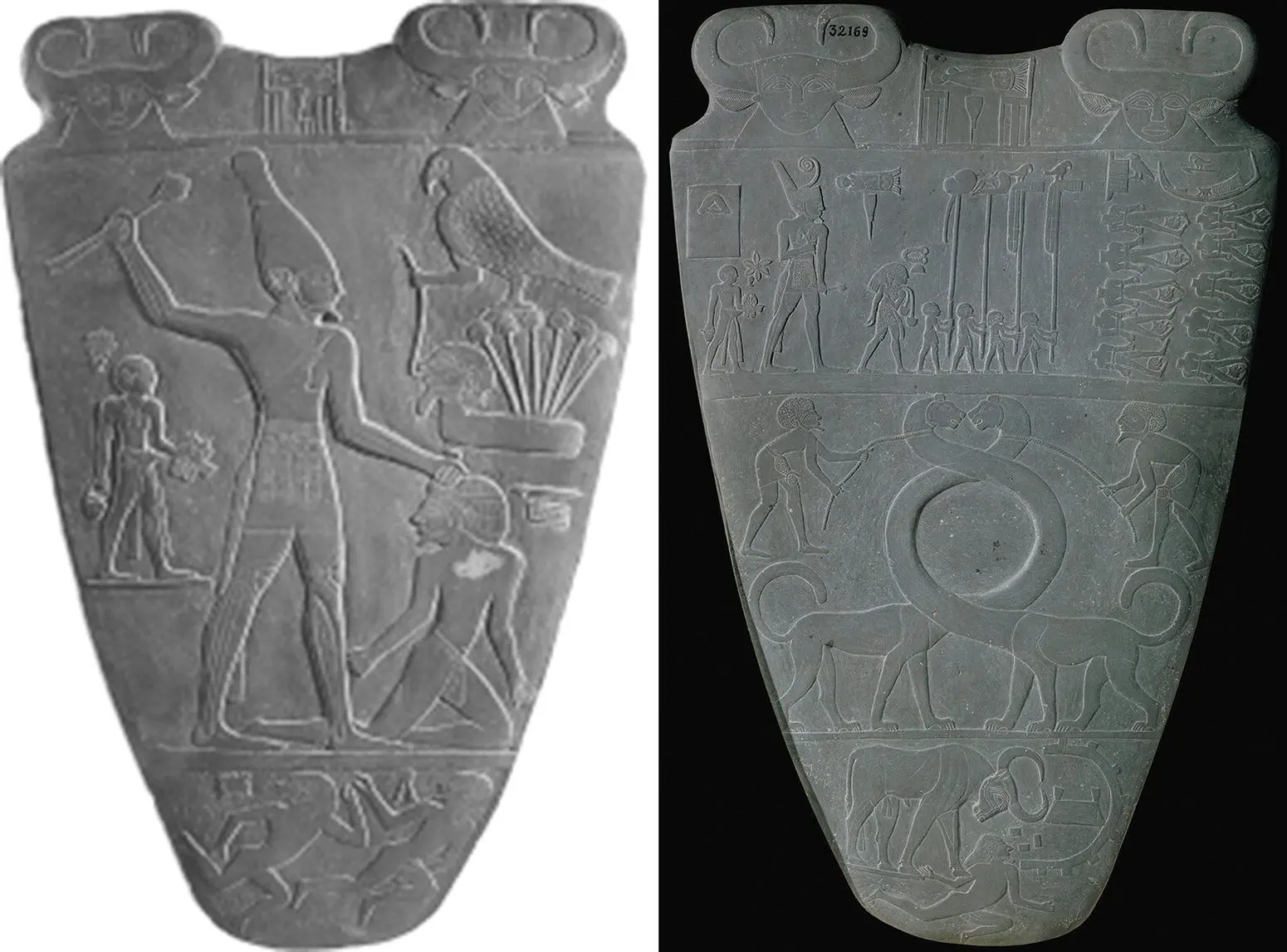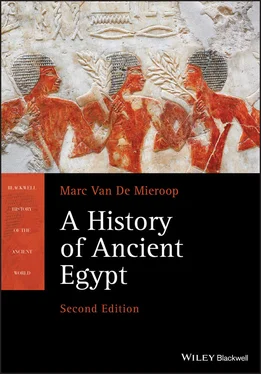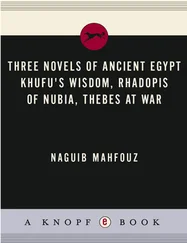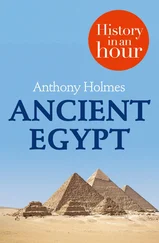2.3 The First Kings
Images of war
Later king lists call the first ruler of the whole of Egypt Menes, but this name does not appear on any of the early monuments. There is thus uncertainty about who can claim the honor of having unified the land, the fundamental characteristic of kingship in Egyptian eyes. It must have been one of the men buried at Abydos, but scholars fail to agree on the identity of Egypt’s first king. Today many suggest he was Aha, but Narmer and other candidates are equally likely. Moreover, the ideal of the unification of Upper and Lower Egypt seems to have been present for some time before the feat was irreversibly accomplished. That Egypt was created through violent means is a basic concept expressed in the art of the period. A sizable set of stone objects, including ceremonial mace heads and palettes, contain scenes of fighting between men, between animals, and between men and animals. The wall painting in tomb 100 at Hierakonpolis (see Chapter 1) seems to be an early example of that imagery, which dominated the art around the time the Egyptian state arose. Whereas in the past Egyptologists read the scenes of war literally as records of actual events, today they prefer to see them as stereotypical statements of kingship and the king’s legitimacy. This new approach makes it impossible to date the unification of Egypt or attribute it to a specific individual on the basis of these representations. But the art of the period shows that the Egyptians linked unification with conflict. The king or king‐like figure is always prominent in these depictions and he can engage in acts of great cruelty, such as decapitation and hanging.
Many of the objects containing these scenes were excavated as a group at Hierakonpolis. Among them several inscribed with the name of Narmer stand out because of the detail of their scenes. We can read Narmer’s palette, a 25‐inch‐ (64‐centimeter‐) high thin flat slab, as one of the first royal inscriptions from Egypt ( Figure 2.3). One side shows a king wearing the high white crown of Upper Egypt beating another man with a mace. Near the second man are two hieroglyphs that seem to denote the name of a region in the north or the victim’s name. Above them is a falcon perched on a papyrus plant holding a rope around a man’s neck, which we can read as the god Horus, represented as a falcon, handing over the conquered Delta to the king. On the other side, the same king wearing the square red crown of Lower Egypt reviews standard‐bearing troops. To their right are two rows of decapitated bodies with the heads between their legs – on top of each head, except for one, lays a cut off penis. Two hieroglyphs in the top registers of both sides identify the king as Narmer. The exact meaning of the scenes remains opaque, but overall the monument seems to declare that King Narmer of Upper Egypt defeated the Delta, and thus became king of Lower Egypt as well. Scholars question the literal reading of Narmer’s palette as an account of the first conquest of the Delta, but regard the representation as one of several statements that the Egyptian king was obliged to keep the country united, through military means if needed.

Figure 2.3 The monumental Palette of King Narmer (front and back shown here), measuring 64 by 42 cm and carved from black schist stone, depicts the king with the crown of Upper Egypt subduing a man who represents the Nile Delta. On the reverse the same Narmer, wearing the crown of Lower Egypt and accompanied by men carrying standards, reviews the bodies of decapitated enemies. Both sides show the royal name in a serekh. Egyptian Museum, Cairo JE 32169.
Source: Erich Lessing / Art Resource
Other men, perhaps earlier than Narmer, appear in similar settings of violence. The Hierakonpolis deposit contains a 10‐inch‐ (25‐centimeter‐) high limestone mace representing a king with the crown of Upper Egypt, possibly engaged in work on canals lined with papyrus plants, a symbol of the Delta. The top register shows lapwing birds hanging from a noose on standards that probably signify various districts of Egypt. In later periods these birds symbolize the general population, and we read the mace head as celebrating the subjugation of people from the Delta by the king (see Figure 1.8). Two signs in front of his mouth seem to render his name: a rosette and a scorpion. As we cannot read these phonetically, scholars refer to the man either as King Scorpion or as King Rosette‐Scorpion.
Historians now regard Scorpion, Narmer, and others to be part of dynasty 0, a group that preceded the traditionally acknowledged rulers of the 1st dynasty. The number of rulers and the length of the period involved are debated. Some read royal names on the tags excavated in the U‐j tomb at Abydos from around 3250, others confine the use of the title “king” to later centuries. It is clear that the concept of kingship predated the unification of the state in Egypt, and that some who ruled only parts of the country had attributes, such as crowns, that were later reserved for kings of all of Egypt. Only with the establishment of the 1st dynasty was all of Egypt brought together in a firm union. Archaeological evidence does not support the idea that this was the result of the conquest of a northern state by a king from the south, as the art suggests. Especially in the Delta, there is no indication of a centralization of power before the 1st dynasty’s unification.
Most likely, the area that incorporated Abydos, Naqada, and Hierakonpolis first grew into a territorial unit and then rapidly expanded into other areas to its north and south. The close connection between these three previously independent centers is clear from the fact that the names of early rulers often appear in more than one site. For example, Narmer was buried in Abydos, but his most significant monuments were in Hierakonpolis, while his wife’s tomb may have been at Naqada. The annexation of Delta regions was the final act in this expansion.
Whatever the processes involved, we cannot really explain why a territorial union was pursued. Egypt is very resource rich, especially agriculturally, and there was no need for communities to seek fields far away in order to feed themselves. The desire for luxury goods from Asia – minerals, semi‐precious stones, oils, and wine – may have pushed people from the Abydos region to ensure guaranteed access, but the conquest of all intermediate zones seems a very laborious way to achieve that. Over the years, Egyptologists have suggested numerous explanations for the creation of the Egyptian state (see Key Debate 2.1). Originally, a sudden military conquest was the preferred scenario; today scholars favor the idea of a gradual growth of a unified territory. When compared to other ancient cultures, the creation of Egypt as a territorial state was a rapid process, requiring a few centuries only. Why it happened cannot be answered with confidence.
2.4 Ideological Foundations of the New State
The visual commemorations of the unification of the Egyptian state focus on the person of the king, represented as much larger than others and the only one who takes action. The emphasis on the royal person pervades all aspects of early Egyptian society, and is one of the ideological pillars of Egyptian culture that endured throughout the country’s ancient history. At the creation of the state, the Egyptians formulated a vision of the world and its organization that was fundamental for all that followed in later millennia. They codified ideologies and established procedures and tools as the basis of official life, which would change and evolve in later history, but remained foundational.
Читать дальше













